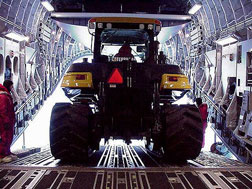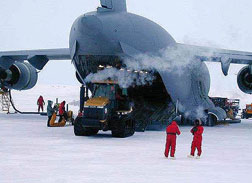|
The 2002-2003
Antarctic research season officially got
underway in late August as U.S. Air Force
transport planes bested snowstorms and
high winds to bring in cargo and personnel
to McMurdo Station, the National Science
Foundation's logistical and scientific
hub on the continent. NSF manages the
U.S. Antarctic Program, the nation's research
endeavor on the southernmost continent.
Dubbed "Winfly," the flights
were the first to land at McMurdo since
the station closed for the austral winter
in February. The annual Winfly missions
allow the Antarctic program to bring scientists
into McMurdo at the beginning of the austral
spring to conduct time-sensitive research,
such as monitoring ozone depletion.
Two C-17 and four C-141 jet transports
brought in a total of 264,054 pounds of
cargo and 304 passengers. The cargo included
12,000 pounds of fresh produce and another
12,300 pounds of mail for those who spent
the winter at the station. The cargo also
included three Challenger 95's, multi-purpose,
tracked vehicles each weighing approximately
38,000 pounds that are used to maintain
runways, skiways and roads. In addition
to U.S. personnel, the plane also brought
in members of the New Zealand Antarctic
Program, which maintains a year-round
station near McMurdo. The planes landed
at Pegasus Field, an ice runway that the
Antarctic Program last spring certified
as suitable for landing wheeled aircraft.
For more information about how NSF meets
the logistical challenges of conducting
science in the Polar Regions, see: http://www.nsf.gov/od/lpa/news/
media/01/fslogistics.htm
|
 |

A U.S. Air Force C-141 transport aircraft
flies into McMurdo Station, the National
Science Foundation's logistical and scientific
hub in Antarctica, in late August. The
plane was among the first to visit the
continent since the station closed for
the austral winter late last spring.
Here is a larger
version of the photo.

A C-17 cargo aircraft, all but obscured
by an Antarctic storm, sits on the ice
runway near McMurdo Station.
Here is a larger
version of the photo.

A U.S. Air Force C-17 cargo aircraft awaits
favorable weather to depart from Antarctica.
Here is a larger
version of the photo.

A Challenger 95 tracked vehicle rolls
out of an aircraft cargo bay. The vehicles
will be used to maintain runways, skiways
and roads.
Here is a larger
version of the photo.

A Challenger 95 emerges from a U.S. Air
Force C-17 cargo aircraft. The vehicle
will be used during the upcoming Antarctic
research season.
Here is a larger
version of the photo.
|

